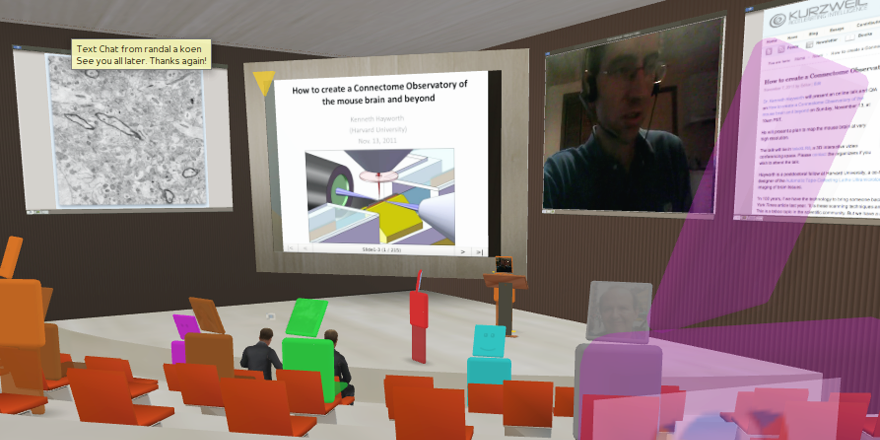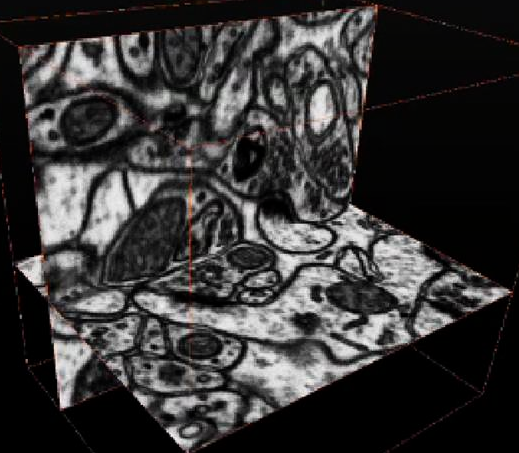A Connectome Observatory for nanoscale brain imaging
November 14, 2011 by Giulio Prisco

Ken Hayworth's online talk on How to create a Connectome Observatory of the mouse brain and beyond (credit: teleXLR8)
Dr. Ken Hayworth, a postdoctoral fellow at Harvard University and designer of the Automatic Tape-Collecting Lathe Ultramicrotome (ATLUM), proposed to build a “Connectome Observatory” for nanoscale brain imaging in an online talk Sunday, How to create a Connectome Observatory of the mouse brain and beyond, presented in teleXLR8, a 3D interactive video conferencing space.
Hayworth suggested that Focused Ion Beam Scanning Electron Microscopes (FIBSEM) now permit imaging brain tissue at resolutions approaching 5x5x5nm. voxel size, down to the protein level. “This is more than sufficient resolution to determine all the connectivity and the properties of the synapses that are needed to explain the functionality of the brain circuits,” he said.
Hayworth presented a technique that can section large blocks of plastic-embedded brain tissue into 20 micron thick strips, optimally sized for high-resolution 5 nm. FIBSEM imaging. This thick sectioning procedure results in such high-quality surfaces that the finest neuronal processes can be traced from strip to strip, permitting a lossless subdivision of brain tissue in blocks that can be imaged by many FIBSEMs working in parallel, he said.
A ‘cure for death’

SEM imaging of brain tissue at resolution approaching 5x5x5 nm. (credit: G. Knott et al./Journal of Visual Experiments)
The Connectome Observatory would be a resource to be shared by the entire neuroscience community, on which individual researchers can schedule imaging time for their projects exploring brain circuits at their finest level. Initially, it would be dedicated to mouse brain imaging for research purposes, but more ambitious applications can be envisaged.
“In 100 years, if we have the technology to bring someone back, it won’t be in a biological body,” Hayworth said in a New York Times article last year. “It is these scanning techniques and mind-uploading that, I think, will bring people back. This is a taboo topic in the scientific community. But we have a cure to death right here. Why aren’t we pursuing it?”
He said many neuroscientists believe that unique individual memory is stored exclusively or primarily in the large-scale synaptic and dendritic structure of the connectome, whose preservation can be the “cure to death,” as noted in “Killed by Bad Philosophy: Why brain preservation followed by mind uploading is a cure for death.”
Hayworth is also a co-founder of the Brain Preservation Foundation (BPF), focused on the exploration of brain preservation technology. The BPF offers a Brain Preservation Technology Prize that will go to the first team to successfully preserve a whole large animal brain in a manner that could also be adopted for humans in a hospital or hospice setting immediately upon clinical death. In the Q&A, participants compared connectome preservation via the chemical brain preservation techniques proposed by the BPF to cryonics.
“If there was really a concerted effort to develop brain preservation technology, it would be easy to have highly reliable hospital brain preservation procedures ready to go in any hospital before the end of the decade. It is all a matter of will.”